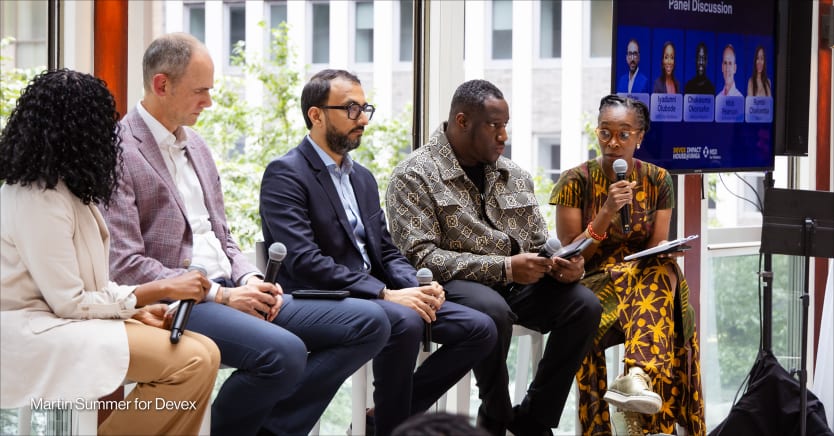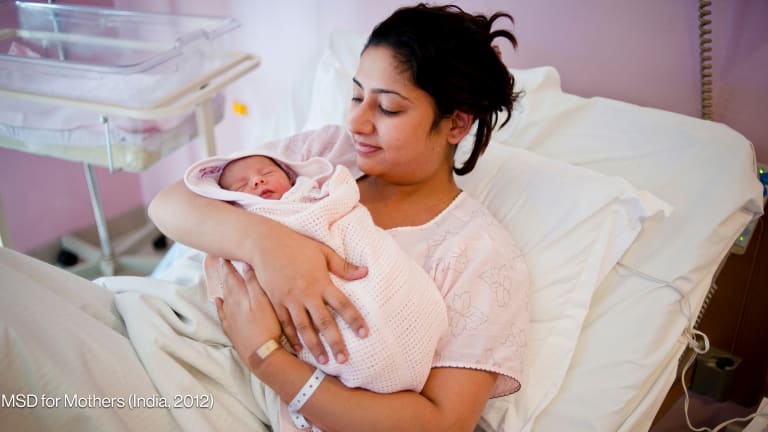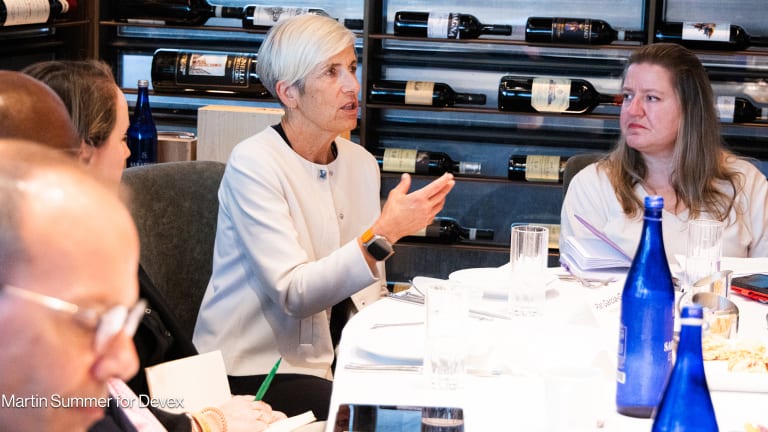
Global maternal mortality has declined over the past two decades, however, every two minutes, a woman still dies from preventable causes related to pregnancy and childbirth. Aid cuts and fiscal constraints threaten to stall progress, with countries at risk of not achieving their national maternal mortality targets by 2030.
With 2030 fast approaching, MSD for Mothers convened a discussion on the sidelines of the 80th United Nations General Assembly, titled Pathways to progress: Strengthening maternal health through sustainable investment. MSD for Mothers brought together leaders from UNICEF, the Gates Foundation, Jacaranda Health, Helium Health and The Blended Finance Company to spotlight how financing innovations can unlock new momentum for maternal health.
Financing models must evolve
Panelists agreed: The status quo is not enough and new financing models that blend public, private, and philanthropic capital are essential.
Representing UNICEF and its Every Woman Every Newborn Everywhere, or EWENE, initiative, Dr. Fouzia Shafique, associate director of health at the U.N. agency, stressed the changes needed to facilitate long-term system resilience, even in fragile settings. “Don’t work across the primary health care system, work with it,” she said. “We have a tendency as humanitarians to want to do things very quickly, which is needed, but then we do it at the expense of leaving the existing system — even if it’s a weak system — to die away. We invest in parallel systems, only to discover during the recovery phase that we could have saved the system, even strengthened it.”
Dr. Sanjana Bhardwaj, deputy director of program advocacy and communications at the Gates Foundation, urged the expansion of traditional public-private partnerships to what she called the “quadruple Ps”: public, private, philanthropy and partnerships — a model that can help unlock coordinated, country-led financing. She noted that proven interventions, such as the global consensus on the prevention, diagnosis, and treatment of postpartum hemorrhage, or PPH, can reduce severe bleeding by 60% for mothers at risk, but scaling requires government leadership and coordinated financing. She highlighted the Beginnings Fund as an example of philanthropy anchoring maternal health investment within national strategies.
Investment should be impact-focused and data-driven
Leaders emphasized that maternal health financing must deliver measurable results for women and newborns, and that data is the key to driving accountability.
First and foremost, a fundamental reframing of maternal health investment is foundational to sustainable progress as urged by Chukwuma Okoroafor, head of legal and executive of strategic partnerships at Helium Health. He reflected, “We need to stop looking at investments in maternal health as a cost, but as an economic multiplier, because healthier mothers make a better workforce, and it also trickles down in the economy. If sustainable financing for maternal health is going to deliver, we must reframe it not as charity, but as economic stabilization.”
Nirav Khambhati, partner at The Blended Finance Company, also acknowledged a needed evolution to leverage blended finance models to create demand for certification and tackle borrowing barriers faced by facilities. He stated, “Philanthropy comes in to actually provide an incentive to those hospitals … as a result of which their cost of capital significantly comes down.” He remarked on the important offering of a first-loss guarantee to financial institutions to encourage lending. This channels more capital to quality-oriented providers and engages mainstream lenders to spread quality through their networks.
Khambhati described MSD for Mothers’ efforts to improve quality of maternal and newborn care services in private facilities in India through the Manyata program. Citing prior findings, where an outcomes-based instrument in Rajasthan linked payments to successful quality certification, he shared that “service providers were getting paid to get hospitals certified for quality, but they would only get paid upon the hospitals reaching successful certification.” The approach ensured philanthropic resources were spent only after results, helping reach over 400 facilities and about half a million mothers, with hundreds of lives saved by extrapolation, he added.
To continue achieving and measuring improved outcomes, Nick Pearson, founder and co-executive director of Jacaranda Health, emphasized that we must lean on data to inform action. “The real power is when you layer in things like data and useful dashboards that are actually co-designed with your government partners,” he said. “Right now, all of us are facing a fire hose of data — everyone’s got dashboards. The real question is how to get that data used, how to present it in a useful way, how to surface the insights in a way that’s meaningful and leads to action.”
Centering communities and building resilient systems
The conversation reinforced that solutions must be rooted in country leadership and community priorities.
Pearson described how technology, when paired with government partnerships, can expand access and improve quality. Through his work at Jacaranda Health, he and his team have worked with mothers, frontline providers, and government partners to enroll women across Kenya into its digital health platform.
“Technology can be both a force multiplier for efficiency and a tool for improving impact,” Pearson said. “But being able to contextualize, both for language and for clinical competency, and setting up the guidelines around delivering that kind of information to mothers, is extremely critical. You really need local organizations that can personalize and contextualize maternal health information.”
Striving to make solutions such as Pearson’s example fully sustainable requires building on strong governance and engaging all levels of the health system, as remarked by Iyadunni Olubode, lead of Kenya and Nigeria programs at MSD for Mothers.
“First, we need to understand the policy frameworks and governance frameworks around health, broadly, and maternal health,” she said. “This means identifying the critical stakeholders in government, in professional spaces, and in civil society that are working in those spaces.” She noted that while national policies are important, the rubber meets the road at the subnational levels, given their authority over budgets and spending decisions. Engaging those at community level, such as ward development committees, religious leaders, and community leaders is also critical to help carry out solutions on the ground.
Pursuing human-centered design and facilitating processes that gather insights from women, communities, health workers, and policymakers to shape solutions was a clear call to action from leaders throughout the discussion.

A path forward
With just five years remaining to achieve the Sustainable Development Goal target on maternal mortality, momentum cannot stall. Before concluding the session, poet and U.N. global advocate for peace Maryam Bukar Hassan reflected on the importance of elevating youth- and community-led initiatives for sustainable progress.
She ended with a powerful call-to-action from her original poem: “When we decide wombs are not battlefields, when we decide mothers are not martyrs, when we decide that to give life should never mean bargaining with death.”
Her words captured the spirit of the discussion: Sustainable financing for maternal health is not only a moral imperative, but also a foundational investment in stronger societies and healthier generations.
The Funding the Future series is supported by funding from MSD, through its MSD for Mothers program, and is the sole responsibility of the authors. MSD for Mothers is an initiative of Merck & Co. Inc., in Rahway, N.J., U.S.A.
Join the conversation on finding private sector solutions to improve health service delivery for reproductive, maternal, newborn, child, and adolescent health (RMNCAH).









